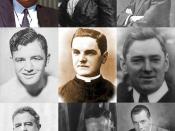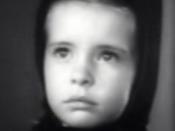A Cultural Analysis of Mary Lerner's "Little Selves"ÃÂ Every story that has ever been written has some aspect that is relevant to the time period the story was written in. Published in 1916, "Little Selves"ÃÂ is entwined with the past issues pertaining to the surge in immigration, namely the Irish immigrant life. The cultural issue of the importance of one's heritage manifests itself throughout the story and drives the story in the end. Although the issue isn't entirely unique for the time period, the story remains to be a good reflection of the Irish culture during the early 20th Century.
The early 1900's were a time of change for most Irish folk. Many of them were immigrating over to America in search of a better life, but for many of the immigrants, there was a lingering feeling of loss. Many Irish-Americans felt that their heritage was on the brink of extinction since those few who could remember their homeland were slowly perishing as the days went on.
Their cultural heritage gained more and more importance after it started to fade from the memories of all with Irish blood. This cultural aspect is portrayed in the character Margaret O'Brien, the elderly woman lying on her deathbed in the hospital. She too is worried about the fading memories, for there's "nobody but me left to remember, and soon there'll not even be that"ÃÂ (16). All of her friends come to pay their last respects, but end up leaving troubled for they don't understand her murmuring dilemma. Margaret never explains her predicament to her new American friends for they are all "outside the magic circle of comprehension"ÃÂ (17), that is until her niece Anna shows up and vows to remember all events of Margaret's past. Finally, the old lady could die peacefully knowing that her heritage remains in the mind of her kin, just as every Irish immigrant had probably wished for.
The culture issue is the main, dominating subject of the story, but that isn't to say it drives the entire story. In the beginnings of "Little Selves"ÃÂ, the reader is left wondering what the old woman is yearning for under her breath, for "her attention wandered; her replies became cryptic"ÃÂ (7). It is this uncertainty that drives the story and the reader towards the end, but once the niece finds out about Margaret's story of the red coat, the attention of the reader is geared towards the relevance of the story. At this point in "Little Selves"ÃÂ, the driving force is shifted to the dilemma of the fading memories of the Irish heritage, or the memory of the red coat, which was just another piece to the puzzle that was Margaret's life in Ireland.
This cultural topic is unique for its time only because it was more prevalent to many Irish-Americans in the early 1900's than it is today. There are not as many Irish immigrants today as there was during the early 20th Century, and for those Americans with Irish ancestors, there has been almost an entire century to adapt and adjust to the separation from the homeland heritage. Still, many fathers and mothers of Irish blood probably get around to telling their sons and daughters about the stories of Ireland that were handed down by their fathers, and all the way back to the first family members that came over from Ireland, just as Margaret described her own memories to her niece.





